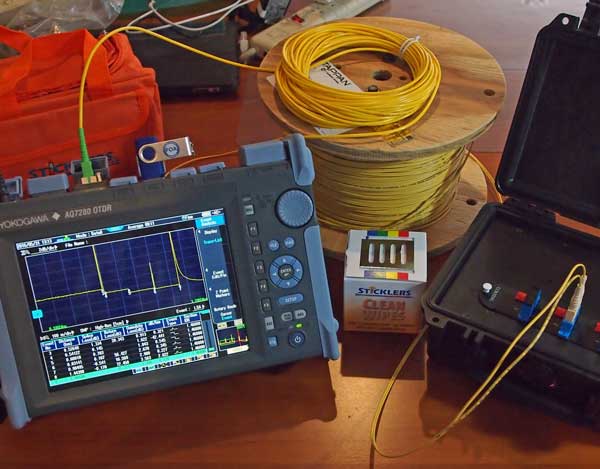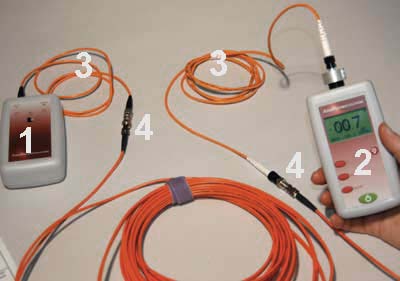Future innovations in optical fibre diameter analyzer technology for network systems
Understanding How an Optical Measurement System Enhances Precision in Industrial Applications
Optical measurement systems play an essential duty in enhancing accuracy throughout various industrial applications. By leveraging innovative technologies such as laser interferometry and 3D imaging sensing units, these systems use high-resolution, non-contact dimensions. This capability lessens the risk of damaging delicate components while making sure precision. The effect of these systems prolongs beyond mere dimensions. Discovering their benefits, applications, and future patterns exposes a complex landscape of technology and difficulties that advantages more detailed assessment.
The Fundamentals of Optical Measurement Systems
Optical measurement systems work as essential tools in different commercial applications, supplying exact information collection and evaluation. These systems make use of light as a key means of measurement, leveraging optical concepts to examine measurements, placements, and surface area features of things. They incorporate parts such as lasers, video cameras, and sensing units, which interact to capture high-resolution pictures and information.
The technology enables non-contact dimensions, reducing the risk of damaging sensitive parts. Optical measurement systems are flexible, finding energy in quality assurance, setting up confirmation, and dimensional evaluation across different markets. They are particularly reliable in atmospheres where typical measurement techniques might fail, such as measuring intricate geometries or observing quick motions.
As industries proceed to develop, the assimilation of optical measurement systems will certainly continue to be critical for making sure accuracy and effectiveness, inevitably improving item high quality and functional performance in numerous manufacturing procedures.
Trick Technologies Behind Optical Measurement
Trick modern technologies such as laser interferometry techniques and 3D imaging sensing units play an important function in the efficiency of optical measurement systems (optical fibre diameter analyser). These technologies make it possible for accurate dimensions and thorough analysis in different industrial applications. Comprehending their functionalities is necessary for using the full possibility of optical measurement systems
Laser Interferometry Techniques
Numerous laser interferometry techniques have actually changed the area of optical measurement, offering unprecedented precision and accuracy in different industrial applications. These strategies utilize the disturbance of meaningful light waves to determine distance, displacement, and surface irregularities with nanometer-level precision. Common techniques include Michelson interferometry, which divides a light beam of light and analyzes stage changes, and Fabry-Pérot interferometry, understood for its high resolution in gauging tiny changes. In addition, laser Doppler interferometry employs frequency shifts to analyze velocity, making it important in dynamic measurements. The adaptability of these strategies enables for their combination into varied manufacturing processes, enhancing top quality control and making sure adherence to rigorous tolerances. Therefore, laser interferometry remains to play a vital duty ahead of time industrial measurement standards.
3D Imaging Sensors
Improvements in measurement technology have caused the growth of 3D imaging sensors, which play a substantial duty in optical measurement systems. These sensors capture three-dimensional data with different techniques such as triangulation, time-of-flight, and structured light. By properly reconstructing the form and dimensions of things, 3D imaging sensors boost the accuracy of measurements in commercial applications. They provide real-time responses, facilitating quality control and guaranteeing that elements fulfill stringent specifications. In addition, their ability to run in challenging settings, such as differing lighting conditions, makes them important in making procedures. As markets significantly adopt automation, the integration of 3D imaging sensors right into optical measurement systems is expected to drive more improvements in performance and precision.
Advantages of Optical Measurement in Market
Standard measurement methods have actually long been the criterion in industrial settings, optical measurement systems supply significant benefits that boost accuracy and effectiveness. These systems utilize light to capture data, leading to high-resolution measurements that are commonly unattainable with conventional techniques. The non-contact nature of optical measurements reduces the threat of damaging sensitive elements throughout the assessment procedure. Additionally, the rate of optical dimensions enables quick data acquisition, helping with timely decision-making in fast-paced industrial atmospheres.
Optical systems are adaptable, qualified of determining different products and shapes without the requirement for considerable recalibration. This versatility adds to boosted workflow and efficiency. Additionally, the automation potential of optical measurement systems decreases human mistake, making certain consistent top quality control. Generally, the assimilation of optical measurement technology stands for a progressive shift towards enhanced precision and dependability in industrial operations, eventually causing boosted product high quality and operational efficiency.
Applications of Optical Measurement Systems

Optical measurement systems play a pivotal function in enhancing manufacturing process optimization by supplying accurate information for decision-making. These systems assure quality assurance guarantee via real-time tracking and evaluation of manufacturing metrics. As sectors increasingly take on these technologies, their effect on performance and item dependability comes to be evident.
Manufacturing Process Optimization
Enhancing manufacturing process efficiency is increasingly reliant on the assimilation of optical measurement systems. These systems supply real-time data on numerous parameters, enabling producers to examine processes with a high degree of precision. By making it possible for precise dimensions of dimensions, surface area attributes, and product homes, optical measurement systems help with the recognition of inefficiencies and bottlenecks in look what i found manufacturing lines. The prompt feedback from these systems encourages engineers to make enlightened choices, resulting in enhanced machining, assembly, and ending up procedures. The capability to monitor conditions continuously enables for adaptive changes, reducing downtime and waste. As sectors purpose for greater productivity and lowered functional costs, optical measurement systems become essential devices for boosting production procedure optimization.

High Quality Control Assurance
The assimilation of optical measurement systems greatly influences quality assurance assurance in commercial setups. These systems provide exact and non-destructive dimensions, allowing makers to spot defects and inconsistencies early in the manufacturing process. By utilizing sophisticated imaging strategies, such as laser triangulation and interferometry, optical measurement systems guarantee that elements fulfill strict requirements. This assists in real-time monitoring, minimizing waste and lessening the threat of malfunctioning products getting to the market. Additionally, the information gathered can be analyzed to fine-tune production processes further, resulting in continual improvement. Ultimately, the adoption of optical measurement systems boosts reliability and uniformity in top quality control, fostering greater self-confidence amongst stakeholders and consumers alike in the end products supplied.
Situation Researches: Successful Executions
Many sectors have successfully incorporated optical measurement systems to enhance their functional effectiveness and product top quality. In the vehicle market, a noticeable maker adopted a laser triangulation system to monitor the alignment of automobile elements. This execution substantially decreased setting up errors, resulting in enhanced safety and security and minimized prices.
In the aerospace market, a leading aircraft supplier used optical assessment for precision measurements of generator blades, attaining a reduction in manufacturing tolerances and far better performance criteria.
A customer electronic devices business implemented optical measurement modern technology during the manufacturing of smartphone displays, resulting in enhanced high quality control and a decrease in defective items.
These study illustrate exactly how optical measurement systems not just improve precision however also add to total functional performance, demonstrating their worth across numerous sectors. By dealing with particular requirements, these systems have actually shown to be crucial devices in modern commercial applications.
Challenges and Limitations of Optical Measurement
While optical measurement systems supply significant benefits in numerous industrial applications, they are not without their difficulties and constraints. One major issue is level of sensitivity to ecological problems, such as temperature changes, moisture, and dust, which can negatively influence measurement precision. In addition, optical systems commonly call for precise placement and calibration, making them susceptible to human error during arrangement and procedure. Another limitation is the potential for interference from ambient light, which can distort measurements and demand intricate filtering system strategies. Certain materials and surfaces may present difficulties, as reflective or transparent attributes can lead to irregular analyses. The price of top notch optical elements and systems can likewise be a barrier for some markets, limiting widespread fostering. Lastly, specialized training is commonly required for personnel to properly run and preserve these systems, including in the total intricacy and operational challenges.
Future Fads in Optical Measurement Modern Technology
As improvements in innovation remain to form industrial processes, the future of optical measurement systems is positioned for significant advancement. Emerging trends suggest a shift in the direction of enhanced assimilation of man-made intelligence and equipment discovering, go to my site enabling systems to analyze information in real-time, identify patterns, and improve decision-making procedures. In enhancement, the development of miniaturized sensing units and advanced optics is anticipated to result in even more portable and functional measurement remedies, making them obtainable for a bigger variety of applications.
In addition, the consolidation of 3D imaging and high-resolution capabilities will certainly enable extraordinary accuracy in measurements, which is essential for markets such as aerospace and vehicle. The promote automation and Industry 4.0 will certainly additionally drive the need for optical measurement systems that can easily user interface with various other modern technologies. As these trends unfold, optical measurement systems will likely become indispensable to attaining greater effectiveness and precision throughout numerous commercial sectors.

Frequently Asked Questions
Just How Do Optical Measurement Systems Contrast to Typical Measurement Methods?
Optical measurement systems supply higher accuracy and rate compared to traditional approaches - optical measurement system. They minimize human mistake, improve data view publisher site collection performance, and provide real-time results, making them increasingly favored in various industrial applications for precise dimensions
What Industries Advantage one of the most From Optical Measurement Systems?
Optical measurement systems significantly profit markets such as aerospace, vehicle, and electronic devices. Their capability to give high-precision measurements boosts high quality control, reduces production mistakes, and improves general efficiency, making them important in affordable production atmospheres.
Can Optical Measurement Systems Be Custom-made for Specific Applications?
Optical measurement systems can undoubtedly be customized for particular applications. By readjusting parameters such as wavelength, resolution, and calibration methods, sectors can tailor these systems to satisfy one-of-a-kind precision and accuracy demands properly.
What Is the Maintenance Requirement for Optical Measurement Systems?
The maintenance needs for optical measurement systems typically include routine calibration, cleansing of optical parts, and software updates. Complying with these methods warranties accuracy, reliability, and durability of the measurement tools in different applications.
Just How Do Ecological Variables Affect Optical Measurement Accuracy?
Environmental elements, such as temperature variations, moisture, and dust, considerably impact optical measurement accuracy. These elements can misshape light paths and interfere with sensor readings, ultimately compromising the dependability and precision of measurements in commercial setups.